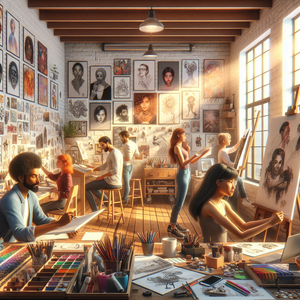
The Thriving World of Freelance Illustration: Your Guide to Success
Diving into a freelance illustration career is not just about creating beautiful images; it’s a chance to blend your artistic talents with entrepreneurial spirit. As the digital landscape expands, the need for skilled illustrators grows across various fields, including publishing, marketing, and entertainment. This guide will walk you through the essential steps to launch your freelance journey, offering insights into honing your artistic skills, building connections, and mastering the business side of freelancing.
Job Summaries:
Key Steps to Kickstart Your Freelance Illustration Career:
- Refine Your Artistic Skills: Continuously improve your illustration techniques by experimenting with various styles and mediums. Online courses, workshops, and dedicated practice are excellent avenues for development.
- Create a Professional Portfolio: Your portfolio is your visual resume. Curate a collection of your best work that highlights your unique style and versatility. Aim for a mix of projects to attract a diverse clientele.
- Engage in Networking: Attend industry events, participate in online forums, and connect with fellow illustrators and potential clients. Building relationships can lead to collaborations and job offers that you might otherwise miss.
- Understand the Business Fundamentals: Get comfortable with the business side of freelancing, including contracts, pricing models, and client management. A solid grasp of these elements will help you navigate the freelance landscape effectively.
- Market Yourself: Harness the power of social media, develop a professional website, and consider joining freelance platforms to boost your visibility and draw in clients.
- Stay Updated: Keep an eye on industry trends, emerging technologies, and market needs to ensure your skills remain relevant and in demand.
Overview of Freelance Illustration Roles:
- Freelance Illustrator: Produces artwork for various sectors, requiring strong drawing skills and design software proficiency. Networking and a compelling portfolio are vital for securing clients.
- Children’s Book Illustrator: Focuses on captivating visuals for children's literature, demanding expertise in color theory and character design. Previous experience in children’s media can enhance your portfolio.
- Concept Artist: Works with gaming and film industries, bringing characters and environments to life. This role requires excellent drawing skills and collaboration with directors.
- Graphic Novel Illustrator: Merges narrative with sequential art, necessitating storytelling skills and familiarity with comic conventions. A specialized portfolio is essential.
- Fashion Illustrator: Creates images that reflect clothing and trends, requiring a keen eye for detail and an understanding of fashion history.
- Medical Illustrator: Produces intricate visuals for educational content, necessitating a strong foundation in anatomy and medical processes.
- Storyboarding Artist: Develops visual sequences for film and TV, requiring strong drawing skills and an understanding of visual storytelling.
- Editorial Illustrator: Creates images for print and digital publications, often conveying complex ideas visually. A diverse portfolio is beneficial in this fast-paced arena.
- Character Designer: Designs unique characters for various media, blending creativity with strong drawing skills.
- Tattoo Artist: Crafts custom designs for clients, requiring both artistic talent and excellent customer service.
- Packaging Designer: Develops visually appealing and functional product packaging, necessitating a solid understanding of branding.
- Illustrative Designer: Combines graphic design with illustration to create marketing materials that resonate with brand identities.
- Visual Development Artist: Shapes the visual style for projects, needing proficiency in sketching and design software.
- Infographic Designer: Creates engaging graphics for data representation, requiring a strong grasp of graphic design and data visualization techniques.
- 3D Illustrator: Produces detailed three-dimensional visuals, necessitating expertise in modeling software.
- Animation Illustrator: Breathes life into characters for animated media, requiring a solid foundation in drawing and animation principles.
- Art Director: Oversees the visual aspects of projects, needing strong leadership and design skills.
- Advertising Illustrator: Develops visuals for marketing campaigns, requiring adaptability and robust drawing capabilities.
- Surface Pattern Designer: Creates patterns for textiles and wallpapers, necessitating a keen eye for color and design trends.
- Muralist: Crafts large-scale public artworks, needing strong artistic skills and collaboration with clients.
The field of freelance illustration is rich with opportunities for those willing to dedicate themselves to their craft. By following the outlined steps and understanding the various roles available, aspiring illustrators can navigate their career journeys more effectively. For those ready to take the plunge, the freelance illustration world is brimming with potential. Connect with the creative community, explore current job openings, and unleash your artistic talents in this vibrant industry. Your path to success starts here!
Explore More Jobs

